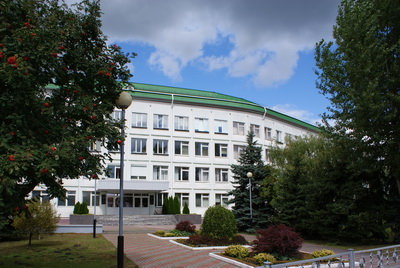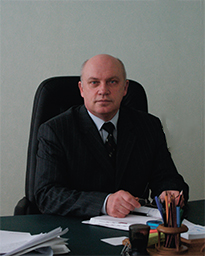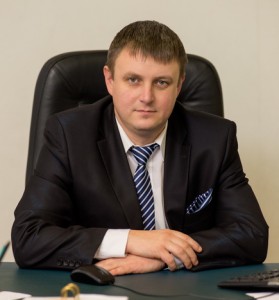
Institute of Radiobiology was established in 1987 in response to the Chernobyl disaster and was first operating as a Gerontology Sector of the BSSR Academy of Sciences in accordance with its Presidium Decree no. 17 of 12 Feb 1987 and following USSR Council of Ministers Decision no. 2618р of 26 Dec 1986 and BSSR Council of Ministers Order no. 25 of 28 Jan 1987.
IRB range of research activities was approved to cover the following areas:
• understand the mechanisms and effects of ionizing radiation on metabolism regulation and functional state of the primary body systems in order to develop enhanced radioresistance methods;
• study radionuclides behaviour, accumulation and removal regularities, and work out the ways to control these processes;
• evaluate the radioecological situation and its impact on living organisms.
The Decree of BSSR Council of Ministers no. 273-20 of 19 August 1987 assigned IRB a republic’s flagship institution for tackling scientific challenges associated with the Chernobyl consequences.
The leadership over IRB organization and management was entrusted with Konoplya Evgenij Fedorovich, a corresponding member of the Academy of Sciences (in 1989 awarded a title of Academician) and an exceptionally competent specialist in biochemistry and radiobiology who headed the institute from 1987 through to 2009. Evgenij Konoplya’s main scientific interest was in studying the effects of ionizing radiation on a living organism, associated pathology occurrence and progression, development of diagnostics methods, treatment and prophylactics of diseases. Before his IRB years, Konoplya was in charge of a Gerontology Sector of the BSSR Academy of Science and supervised biochemical laboratory research focused on developing new hyperglycemia and hyperthermia treatment methods by means of radiation and chemical therapy.
First IRB laboratories were scattered here and there, housed by several NASB institutions in Minsk. Thus, Biochemistry, Endocrinology, Physiology, Morphology and Cytogenetics labs were located in Microbiology Institute. Soil Radiochemistry lab operated in the Institute of Physical and Organic Chemistry, and Sosny Joint Institute for Power and Nuclear Research housed IRB labs of Aerial Radioecology, Dosimetry & Radiometry, Water Radioecology, and a Toxicology Team.
In 2003, following the NASB Presidium Decree no. 35 of 17 Apr 2003 and in the fulfilment of the Order of the President of the Republic of Belarus, IRB was permanently relocated from the capital Minsk to the city of Gomel. To station the institute’s headquarters, NASB provided the former building of Metallpolymer Special Design and Technological Bureau (4, Fedyuninskogo St.). The building was renovated and appropriate construction adjustments were made to cater the needs of research laboratories and in terms of radiation safety requirements. In the same year, IRB was joined by the laboratory of Radiation and Toxicological Ecology, originally belonging to Sosny Joint Institute for Power and Nuclear Research.
Taking into account the importance and specifics of research missions assigned to IRB laboratories, they were thoroughly designed and equipped with the latest laboratory instrumentation and devices for biochemistry, molecular biology, genetics, immunology and radioecology research.
IRB beginnings and development are closely associated with such distinguished Belarusian scientists as Academician E. Konoplya, Doctors of Sciences Naumov A.D., Malenchenko A.Ya., Lobanok L.M., Bagel I.M., Gacko G.G., Amvrosyev A.P., Rolevich I.V., Candidates of Sciences Kudryashov V.P., Baneckaya N.V., Bondar Yu.I., Mironov V.P., Knatko V.A., Hodosovskaya A.M., Sushko S.N., Vereshchako G.G., and many others.
In the first years after the Chernobyl NPP accident, IRB specialists were evaluating the existing situation and providing predictive estimates of radioactive contamination of Belarus territory (137Cs, 90Sr, transuranic elements, short-lived isotopes etc.), studying the behaviour of radionuclides in soil, water, air, living organisms, along with giving suggestions on how to control these processes. IRB largely contributed to understanding the mechanisms of ionizing radiation and elaborating the ways of reducing and preventing its negative effects on organisms, progeny and generations. Its findings and scientific proposals were relied on for developing relevant protective measures on the national and local legislative levels.
In 1988, alongside with various cross-specialized institutions and organizations of Byelorussian SSR, IRB joins research efforts in the Chernobyl exclusion zone in the framework of the Programme of Scientific, Research and Experimental Actions.
During 1989–1992, IRB is involved in the Inter-Republican Comprehensive Research Programme, Molecular Radiobiology Section, studying the effects of low doses of external and internal radiation on the mechanisms of hormonal metabolism regulation and cellular functions, as well as structural changes in organs and tissues at different stages, including the embryo development stage.
Starting from 1990, IRB becomes one of the major actors and contractors of the State Program on Overcoming the Consequences of the Chernobyl Disaster, particularly in its sub-division: “Solutions to long-term problems of radiobiological and radioecological consequences of the Chernobyl disaster”.
In 1998, IRB joins in the Programme on Joint Actions of the Union State of Russia and Belarus on Overcoming the Consequences of the Chernobyl Disaster.
Its subsequent research projects IRB has been carrying out continuously in the frameworks of various national R&D programmes, such as: Low Doses of Radiation (1996–2000), Ionizing Radiation (2001–2003), Functions Regulation (2001–2003), Radiation and Anthropoecology (2003–2005), Radiation and Ecosystems (2006–2010), Chemical Materials and Technologies, Environment and Natural Resources (2011–2015), Environment and Natural Resources (2016–2020), State Applied Research Programme “Transboundary Monitoring”, State Science and Technology Programmes “Nuclear Physics Technologies for Belarus National Economies” and “Medicine Remedies”, etc. Annually, IRB is engaged in two to three research tasks financed through Belarusian Republican Foundation for Fundamental Research.
The results of IRB’s studies on the effects of low doses of radiation on human body and other findings form the basis of the Concept of Public Residence in Contaminated Areas describing a complex system of most recent scientifically justified conceptual ideas on strategic actions towards improving the safety of livelihoods, farm management and other living conditions in affected areas.
Furthermore, IRB is also engaged in developing and testing radioprotective agents, dietary supplements and other preparations. For instance, under conditions of acute and chronic radiation, we tested a preparation called “selenmethionine”, a blend of selenium and methionine. One of the newly developed examples is a calcium-based drug “Dopinat” and its modified forms “Dopinat-iodine” and “Dopinat-vitamin D”. Enriched with nutrients, these supplements are used as nutrient additives in bakery and other food production to compensate for mineral deficiency and thus reduce the risk of associated health conditions. Another supplement product developed by IRB, Carbosil, is used in the production of chocolate covered cheese bars “Phuntishka”, Khoiniki Milkavita Factory.
A number of supplements were developed based on microorganisms and fungi (mushrooms) and are covered by authorship certificates. Such is, for example, a supplement developed from a highly radioadsorptive extract of the basidiomycete oyster mushroom (Pleurotus ostreatus L.), licensed for the use, manufacturing and distribution under the approval of the Russian Health Ministry.
So far, IRB’s inventions total to over 50 and are trademarked and patent protected. Over 30 measurement procedures developed by IRB laboratories have been approved by the Committee for Standardization and Metrology. IRB researchers produced more than 20 monographs.
As of today, Institute of Radiobiology has over 40 signed collaboration agreements with research and educational institutions from CIS, European and overseas countries.
Due to close interrelations with the local authorities, IRB inventions and developments can find their utmost practical and efficient implementation tailored to the local needs and the specifics of a local problem caused by the Chernobyl disaster.
IRB is an annual organizer of essential international scientific and scientific-practical conferences.

Naumov Alexander Dmitrievich, Doctor of Biological Sciences, associate professor, was heading the institute from 2009 to 2015. Being a follower of the E. Konoplya’s academic school and as his successor, Alexander Naumov paid special attention to preserving established traditions, but he also made sure to expand research activities and account for the changes in human environment of his time. Thus, for instance, his interests focused on studying interactions between a human body and the sources of non-ionizing electromagnetic radiation in a wide frequency range, as well as on studying and assessing combined effects of various anthropogenic factors such as stress, ionizing radiation etc. on the functional state of the most important body systems (blood, cardiovascular, reproductive and endocrine systems) and finding the ways of disorders correction.

The present-time Director is Cheshik Igor Anatolievich, Candidate of Medical Sciences, associate professor, appointed to the position on 1 July 2015.
Today’s main areas of research include but are not limited to:
• assessment of contamination of individual ecosystems and the territory of Belarus by transuranic elements;
• development of new ways to regulate the uptake of contaminants and radionuclides by agricultural crops;
• understanding the combined effects of chronic exposure and other factors (e.g. stress, electromagnetic irradiation) on the offspring and next generations;
• development, upgrade and introduction of new macro- and micronutrients, gastrointestinal adsorbents and bio-additives to enhance human and farm animals’ resistance against adverse effects of unfavourable environments.
On 15 March 2019, following reorganization ordinance, Institute of Radiobiology merged with Research Institute of Radiology.
As of today, IRB operates 7 laboratories:
– Radioecology;
– Endocrinology & Biochemistry;
– Anthropogenic Risk Modelling and Minimization;
– Combined Effects;
– Experimental Biological Models;
– Environmentally Safe Animal Production under Technogenic Contamination Conditions;
– Agroecology and Mass Analyses.
Additionally, IRB provides a Postgraduate Course in Radiobiology for PhD students.
Close cooperative relationships with the educational institutes and universities help us improve the efficiency of the training provided and better attract talented youth to join scientific communities.
Being affiliated to the Department of Medical Sciences of the National Academy of Sciences of Belarus, IRB acts as a general coordinator of the republic’s fundamental and applied research in radiobiology and radioecology.